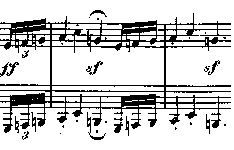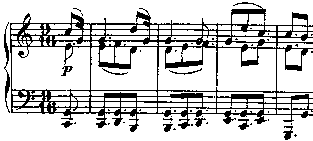Harmony: functional and dysfunctional
by Professor Wilfrid Mellers
Part I: The Beethovenian Crisis (B)
This democratic humanization of music culminated in the work of Beethoven,
who rendered harmony 'functional' in being human as well as musical. In
the sonatas and symphonies of his middle years he made the fiercest assertion
of dichotomy in European music; and his Third Symphony is justifiably termed
'Eroica' because in it his courage in confronting human contrariety is indeed
heroic. This we may hear in the famous crux in the first movement's development
section, wherein quasi-fugal unity cataclysmically erupts in cross-rhythmed
dissonances of hitherto unparalleled ferocity.
In such passages Beethoven demonstrates, from within the Promethean Fire
itself, that (in Kant's words) 'God's Kingdom is in ourselves'. After such
an admission it was inevitable that Beethoven - and humankind - should seek
release from the reign of will-directed functional harmony: an evolution
that occurs during Beethoven's 'third period', and is consummately manifest
in his last piano sonata, opus 111, in two movements, one based on C minor,
the other mostly in C major.
The work begins with a slow introduction founded on classical baroque
idiom, with 'horrendous' diminished sevenths and double-dotted rhythms enacting
the clenched fist with which Beethoven confronted an inimical destiny:
Beethoven: Sonata op.111, opening (maestoso)

This introduction explodes into a first movement allegro that fuses the
contradictory principles of the duality of sonata and the unity of fugue,
with a theme derived from the introduction, combining an upward-thrusting
scale, a rising minor third, and a plunging diminished fourth: a theme that
Beethoven associated with the mythical hero Atlas who, like himself, bore
on his shoulders the burden of the world.
Allegro con brio ed appassionato
|
 |
The coda of this fugued sonata reconciles the opposing energies of its
dynamic first and relatively lyrical second subjects, in the process metamorphosing
C minor into C major: in which 'white' key Beethoven concludes his sonata
with a variation-set which, despite its length, he terms an Arietta rather
than aria, no doubt because it embodies a 'condition of complete simplicity,
costing not less than everything'. The sublime theme of the variations,
remotely derived from the first movement's tempest, eschews, in being 'varied',
any element of sonata-conflict, for the variations are a continuous flowering
of melody, reflecting not so much the 18th century notion of variation as
the 16th century concept of 'divisions', whereby a tune is divided into
ever-smaller note-values as the basic tempo is 'diminished' into its multiples.
Only after this series of variations, moving ever faster in a kind of celestial
boogie-woogie, is there a real shift from the home tonic in a modulatory
retrospect that recalls, as from a vast distance, the turmoil of the first
movement.
 |
Arietta variation
|
After that, the original pulse is re-established, with the arietta melody
soaring on top, in its original form, but with the figuration so rapid that
there is nothing left but trills - a musical synonym for 'the still point
of the turning world'. Beethoven has dissolved 'functional' harmony into
an aural metaphor for paradise; and although no other composer followed
him on that perilous path, the Great Romantics - initially Schubert, Schumann,
Chopin and Brahms - accepted with grace and gratitude the liberation he
had offered from obsessive Will and harmonic functionality.
Copyright © 1999 Wilfrid Mellers
Continue >>
|